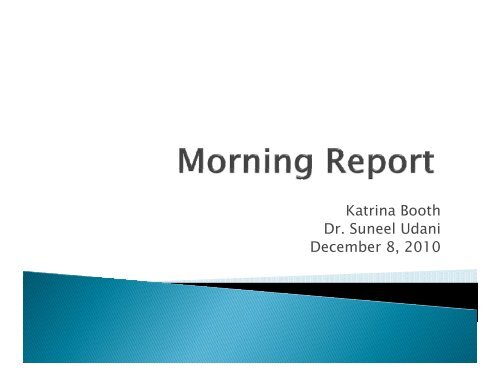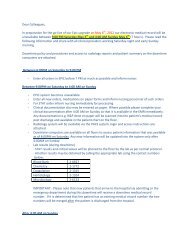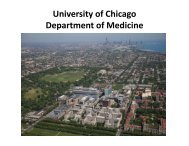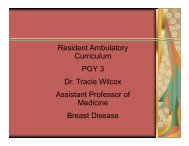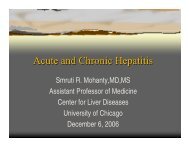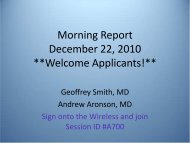Katrina Booth Dr. Suneel Udani December 8, 2010
Katrina Booth Dr. Suneel Udani December 8, 2010
Katrina Booth Dr. Suneel Udani December 8, 2010
Create successful ePaper yourself
Turn your PDF publications into a flip-book with our unique Google optimized e-Paper software.
<strong>Katrina</strong> <strong>Booth</strong><br />
<strong>Dr</strong>. <strong>Suneel</strong> <strong>Udani</strong><br />
<strong>December</strong> 8, <strong>2010</strong>
A 47-year-old man with a long-standing history of<br />
alcoholism is hospitalized for abdominal pain, nausea, and<br />
vomiting omiting of 7 days’ da s’ duration. d ration His last drink was as 6 days da s ago. ago<br />
He has lost approximately 10% of his body weight over the<br />
past 4 months; he states that his weight loss was caused by<br />
drinking alcohol and not eating eating.<br />
On physical examination, he appears cachectic. Temperature<br />
is 37.1 °C (98.8 °F), blood pressure is 100/70 mm Hg, pulse<br />
rate is 110/min, 110/min and respiration rate is 18/min 18/min. BMI is 17 17. He<br />
is not confused or tremulous. There is midepigastric<br />
tenderness without rebound. Bowel sounds are present.<br />
Neurologic g<br />
examination is normal.
Laboratory studies:<br />
Amylase 300 U/L<br />
Lipase 150 U/L<br />
Sodium 130 meq/L (130 mmol/L)<br />
Potassium 3.4 meq/L (3.4 mmol/L)<br />
Chloride 90 meq/L (90 mmol/L)<br />
Bicarbonate 20 meq/L (20 mmol/L)<br />
Phosphorus 3.5 mg/dL (1.1 mmol/L)<br />
Calcium 9.0 mg/dL (2.2 mmol/L)<br />
Urinalysis Positive for ketones
The patient receives immediate thiamine<br />
replacement, folic acid supplementation, and a<br />
multivitamin followed by vigorous intravenous fluid<br />
replacement with 5% dextrose and normal saline<br />
with aggressive potassium replacement. replacement Morphine<br />
is used to control pain.<br />
Eighteen hours later, the patient’s abdominal pain<br />
has improved but he becomes restless, agitated,<br />
and extremely weak and is barely able to raise his<br />
extremities against gravity gravity.
Which of the following is the most likely<br />
cause of this patient’s new findings?<br />
A. Hypercalcemia<br />
BB. HHypokalemia k l i<br />
C. Hyponatremia<br />
DD. Hypophosphatemia
A. Hypercalcemia<br />
yp<br />
B. Hypokalemia<br />
C. Hyponatremia<br />
D. Hypophosphatemia
Which of the following is the most likely<br />
cause of this patient’s new findings?<br />
A. Hypercalcemia<br />
BB. HHypokalemia k l i<br />
C. Hyponatremia<br />
DD. Hypophosphatemia
Severe hypophosphatemia develops in patients with<br />
chronic alcoholism due to:<br />
◦ Poor oral intake<br />
◦ Decreased intestinal absorption due to NV<br />
◦ Increased kidney excretion due to effects of etoh on<br />
tubule<br />
Despite total body depletion of phos, may have normal<br />
lab values on admission<br />
Sudden severe hypophosphatemia can cause confusion,<br />
rhabdomyolysis, hemolytic anemia, severe muscle<br />
weakness k lleading di tto respiratory i t ffailure il
78 yom presents with fatigue, n/v
130<br />
8.8 88<br />
105<br />
13 113<br />
3.9 39<br />
79<br />
9.5<br />
2.5<br />
6.1<br />
26.8<br />
9.7<br />
229<br />
8.3<br />
0.2<br />
3.7<br />
0.1/0.2<br />
N72 L13 M5 47 26<br />
2233<br />
UA: 1.018/5.0/+LE/-- nit/-- prot/2+bld/3-5WBC/occ. RBC<br />
U Na 71 Uosm 483<br />
U K 19 S osm 325<br />
U Cl 25 TTKG 1.45<br />
U Cr 82<br />
U eos 0<br />
FeNA 2.6%
Urine anion gap<br />
◦ UN UNa + UK – UCl<br />
+ gap renal<br />
- gap GI<br />
TTKG<br />
◦ (UK/PK)/(Uosm/Posm)<br />
With hypokalemia<br />
4 = Renal loss; excess aldo<br />
With hyperkalemia<br />
10 = non-renal non renal hyperkalemia (normal aldo)
Proximal<br />
(Type 2)<br />
Classical<br />
Distal<br />
Prevalence Rare Rare Very<br />
common<br />
Type 4 Hyperkalemic<br />
Distal<br />
Common<br />
Plasma K Low Low High High<br />
Urine pH 6
136<br />
104 46<br />
5.2 19 2.0<br />
LDH 1383<br />
82<br />
9.2<br />
1.8<br />
3.9<br />
19.3<br />
ABG: 7.33/36/65/18/90 7 33/36/65/18/90 on RA<br />
10.2 196<br />
N37 Bands16<br />
L17 M12 E6<br />
9.1 3.6<br />
0.4<br />
56<br />
239 39<br />
0.1/0.3<br />
33
78 yoM with h/o HIV p/w cough and fatigue<br />
Cough productive of occ. yellow sputum<br />
Subjective fevers<br />
Night sweats<br />
No GI symptoms<br />
RRecently tl stopped t d HAART th therapy<br />
Last CD4 count 157, May <strong>2010</strong><br />
Recently stopped PCP ppx
PMHx<br />
◦ HIV since i 1999<br />
◦ TB 1999, s/p treatment<br />
◦ Shingles<br />
◦ Suicide attempt 2009<br />
◦ CKD 2/2 HIV<br />
nephropathy, p p y, BL Cr 1.8<br />
PSurgHx<br />
◦ None<br />
Meds<br />
◦ None<br />
Social Hx<br />
◦ Lives Li alone l in i senior i<br />
building, no tobacco,<br />
no EtOH, retired<br />
professor f<br />
Fam Hx<br />
◦ Non-contributoryy<br />
Allg: None
2-10% of HIV patients<br />
Associated with high viral load<br />
Pathogenesis<br />
◦ HIV can infect glomerular epithelial and tubular cells<br />
◦ More common in AA than white<br />
Collapsing FSGS<br />
◦ Most common form (60% of renal biopsies)<br />
◦ NNephrotic h i syndrome d picture i<br />
◦ Before HAART, progressed to ESRD in months<br />
Membranoproliferative GN—seen in coinfection<br />
with Hep C<br />
Immune complex GN—IgA deposits against HIV
Screening<br />
◦ HIV patients that are high risk (high viral load, AA)<br />
◦ Biopsy indicated if > 1 g protein/day<br />
Treatment<br />
Treatment<br />
◦ HAART<br />
◦ ACEI/ARB<br />
◦ ? Prednisone or cyclosporine
Concern for PCP PNA<br />
Started on prednisone and bactrim<br />
Feeling better, sat ok on RA<br />
CD 4 count 127<br />
Discharged on bactrim and prednisone
78 yom with h/o HIV, HIV nephropathy<br />
recently treated for PCP p/w n/v and fatigue
130<br />
8.8 88<br />
105<br />
13 113<br />
3.9 39<br />
79<br />
9.5<br />
2.5<br />
6.1<br />
26.8<br />
9.7<br />
229<br />
8.3<br />
0.2<br />
3.7<br />
0.1/0.2<br />
47 26<br />
UA: 1.018/5.0/+LE/-- nit/-- prot/2+bld/3-5WBC/occ. RBC<br />
U Na 71 Uosm 483<br />
U K 19 S osm 325<br />
U Cl 25<br />
U Cr 82<br />
U eos 0<br />
FeNA 2.6%<br />
2233
EKG changes:<br />
◦ Peaked T waves (B)<br />
◦ Lengthening of PR and QRS (C)<br />
◦ P waves disappear (C)<br />
◦ Sine wave (D)
Given Calcium, D50, insulin, kayexalate
Dysphagia with solids and liquids<br />
Constipation, no BM x 6 days<br />
No F/C<br />
Urinary frequency<br />
Unable to empty bladder<br />
NNo cough, h SOB
VS: T 36.5 BP 138/73 HR 70 RR 13 Sat 94%<br />
Gen: NAD<br />
HEENT: bilateral parotid swelling, L>R, oral<br />
thrush<br />
CV: RRR, no murmurs, no LE edema<br />
Lungs: g CTAB<br />
Abd: NT/ND, +BS, no HSM, suprapubic fullness<br />
Neuro: no focal deficits<br />
Skin: no rashes<br />
Psych: pleasant, AxOx3
Can cause hyperkalemia in any pt<br />
Higher risk in HIV pts<br />
◦ High doses to treat PCP<br />
◦ Frequent underlying kidney disease<br />
◦ HIV pts may also have adrenal insufficiency<br />
Avg g rise of 0.5 0 5 to 1.0 0 meq/L q/<br />
Acts like K-sparing diuretic
Patrick Hallak said... The increase in creatinine associated with TMP<br />
is mild: 10% and reversible with drug discontinuation.<br />
The mechanism of Bactrim induced hyperkalemia is via<br />
TTrimethoprim i th i inhibition i hibiti of f th the sodium di channel h l llocated t d on th the<br />
luminal surface of the principal cells, independent of aldosterone<br />
blockade. ( Same site of action of amiloride , triameterene and<br />
pentamidine). p ) This will decrease sodium reabsorption p and the<br />
electro negativity in the lumen thus decreasing the driving force for<br />
the secretion of potassium through an apically located potassium<br />
channel on the same principal cells. This side effect is most common<br />
in HIV infected patients who are treated with high doses of TMP TMP-<br />
SMX. However hyperkalemia can occur with lower doses used to<br />
treat routine infections. Be cautious thus when using TMP-SMX in<br />
patients with preexisting renal dysfunction or in those taking<br />
concurrent medications (such as angiotensin-converting enzyme<br />
inhibitors and potassium-sparing diuretics) that may exacerbate this<br />
hyperkalemic effect to potentially dangerous levels.<br />
<strong>December</strong> 9, 9 2008 10:43 AM
Further history obtained—h/o BPH requiring<br />
self cath at home. Pt hasn’t been doing this x<br />
several months<br />
What next?
Licurse A et al Renal Ultrasonography in the Evaluation of Acute Kidney<br />
Licurse, A., et al. Renal Ultrasonography in the Evaluation of Acute Kidney<br />
Injury. Arch Intern Med. <strong>2010</strong>; 170(21)1900-1907
Bilateral hydronephrosis (right greater than<br />
left). The right kidney is small in size (9 cm)<br />
with cortical thinning suggesting obstruction<br />
may be chronic in nature nature.
Causes Type 1 distal RTA<br />
Tubular injury reduces activity of Na-K<br />
j y y<br />
ATPase, leading to hyperkalemia<br />
Inability to reabsorb Na leads to higher FeNA<br />
Similar to Type 4 RTA (hypoaldo effect)
Decompression and IVF (usually in chronic)<br />
Treatment for BPH<br />
◦ Alpha blockers<br />
◦ 55-alpha alpha reductase inhibitors<br />
Trial without catheter after 2-3 days<br />
◦ Initial success rate 20-40%<br />
Initial success rate 20 40%<br />
◦ Recurrence is common<br />
Surgical treatment<br />
◦ TURP
Foley inserted—1 L urine returned<br />
Foley catheter left in place<br />
IVF replacement given<br />
Started on Tamsulosin<br />
3 days later, Cr 1.8, Na 138, K 4.2<br />
Di Discharged h d hhome with ith catheter th t and d uro f/u f/<br />
Bactrim changed to Atovaquone
138<br />
99 43<br />
4.3 21 4.5<br />
59<br />
10.0<br />
1.6 <br />
4.5<br />
<br />
144<br />
6.0<br />
108 88<br />
13<br />
Uric acid 18.514.09.9
Can get much information from renal labs<br />
HIV nephropathy common in HIV pts<br />
Bactrim increases risk of hyperkalemia in HIV<br />
pts, esp pts with ihHIV HIV nephropathy h h<br />
Treatment of acute urinary retention-foley,<br />
alpha blocker and fluids


